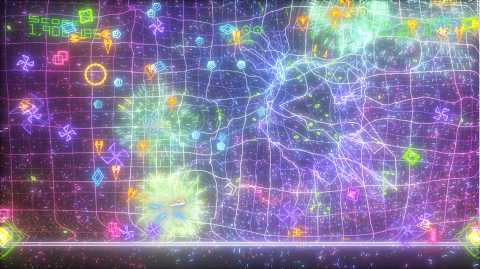Geometry Wars: Retro Evolved 2 Review
Geometry Wars: Retro Evolved 2 adds new modes and elements that make it significantly better than both its predecessor and the scads of dual-joystick shooters that were released in its wake.

Retro Evolved 2 manages this by making interesting tweaks to the core gameplay, updating the graphics, and putting additional modes in to ensure that players of all skill levels have something to do. The gameplay changes are mostly focused on scoring. When you shoot an enemy, it drops little dots called geoms, which increase your multiplier when collected. That multiplier stays with you for the entire game, unlike the previous Retro Evolved, which put more importance on staying alive to keep your multiplier up. Also, outside of multiplayer mode power-ups, your weapon doesn't upgrade. You always know exactly how you're going to be shooting. The game also introduces new enemies and obstacles, including a bubbly cloud that's only vulnerable when you carve a path to its creamy center, dart-shaped ships that quickly travel along a set line, and so on.
The different modes take these basic ideas and flip them in interesting ways. The modes are locked at first, but as you score points in the first available mode, you earn your way to the next mode. Even players with low skill could probably unlock all six modes within the first couple hours of play.
The first mode is called deadline, and it gives you infinite lives. The catch is that it only goes for three minutes, which places more emphasis on quickly dispatching enemies and collecting geoms for a high score, rather than simply testing your survival skills.
King mode unlocks next, and this version gives you one life and no bombs. Circles act as safe havens on the screen--enemies can't get into the circle, but once you enter, it quickly shrinks and disappears. Also, you can't fire when you're outside a circle, so finding the right time to dart from a collapsing circle to a fresh one is the key skill.

Playing Evolved unlocks Pacifism, which gives you one life. You can't shoot at all in this mode, but you'll still have to deal with a never-ending stream of enemies by dodging them and flying through gates, which explode and eliminate nearby foes when you activate them.
Waves mode is another one-life mode that sends enemies at you in, you know, waves. This mode focuses heavily on the dart-shaped ships, which come at you from all sides.
The final mode is Sequence, which is a level-based progression through the game that gives you 20 levels to play through. You have 30 seconds to clear each stage, and if you die, the game moves on to the next stage, which keeps things moving, but you also sacrifice potential points in the process.
The game's achievements give you more to do in each mode, such as "wax on" and "wax off" achievements for scraping the walls of the arena in Pacifism. One full lap gives you wax on, but getting two full laps for wax off is much tougher. The game acknowledges when you are attempting achievements like this, by popping up a counter that shows how close you are to getting it done. Overall, the achievements in this game feel a lot easier than the previous game's were, but that comes down to your own personal skill at Geometry Wars.
Each of the game's modes can be played in multiplayer mode with up to four players. You can play co-op, break the players up into teams, or just compete for score against the other three players. The catch is that all of this must be done locally. While there's probably a pretty good technical reason for why such a fast-moving, split-second game might not work so well online, it still stands out as the one thing this game is missing. As such, the main competition comes out of the single-player leaderboards, which are always staring you in the face from the mode select screen, informing you that there's probably someone on your friends list who is better than you are. It's enough to make you crazy. It's enough to keep you up at night.

The music and sound are also fantastic. A big part of what set Geometry Wars apart from other games of its type is the way it used sound. Every enemy has a unique sound that plays when it appears on the grid. This is still true in Retro Evolved 2, and it continues to be a very handy feature. Each mode has its own music, including an updated version of the original theme, which appears in Evolved mode. There are some great minor touches with the music, too, like the way it muffles in King mode whenever you're outside of a ring, or the way it halts when you die in Evolved mode, like someone slammed the cutoff knob all the way down while slapping a hand on a record to stop it all at once, only to quickly ramp back up when you respawn.
Even if you've grown tired of the seemingly endless cavalcade of dual-joystick shooters that Geometry Wars: Retro Evolved's success spawned on Xbox Live Arcade, the sequel is well-worth its $10 price tag.
